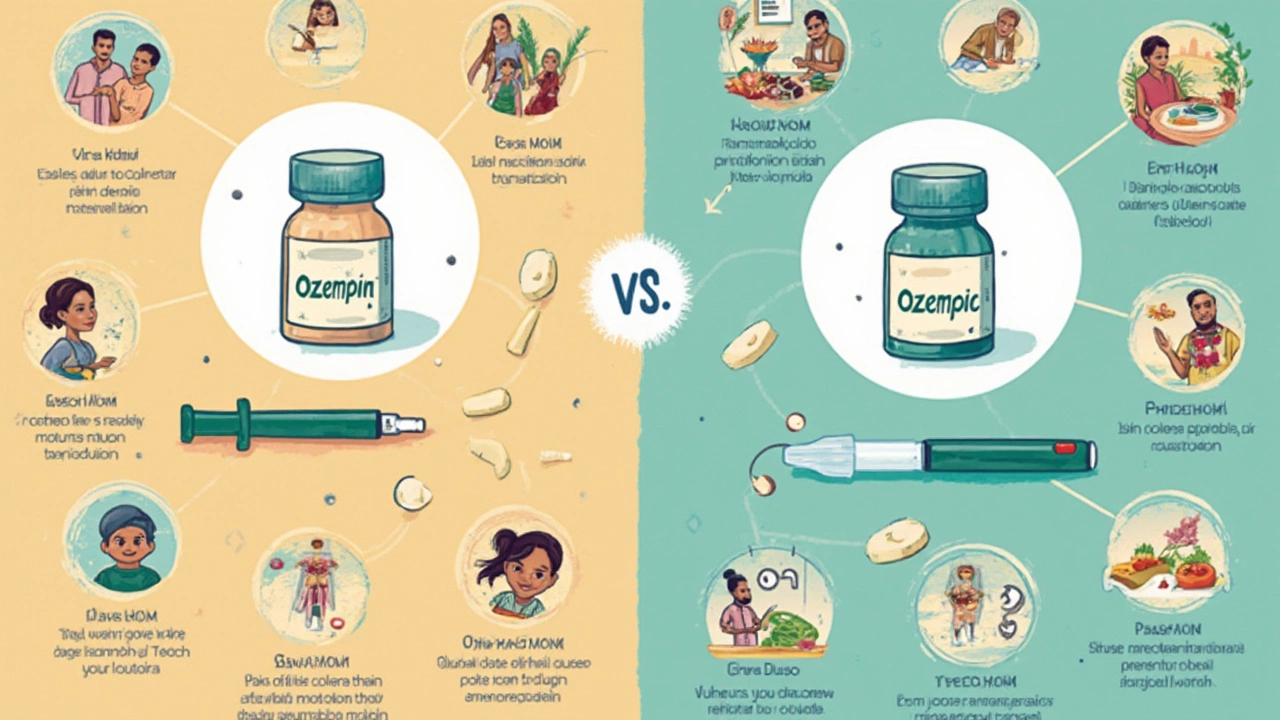-
1

Metformin vs Ozempic: How Do These Diabetes Drugs Really Compare?
People toss around the names metformin and Ozempic all the time—at BBQs, online forums, even those whispered conversations at the pharmacy. Maybe it’s because these two drugs keep popping up in news feeds, linked to treating type 2 diabetes and, lately, major weight loss. So, are they the same thing with a different name? Not even close. This is one of those cases where it pays off to look at the fine print—your health might depend on it.
How Metformin and Ozempic Work in the Body
You’d think if two meds are used for diabetes, they’d work the same way. They don’t. Metformin, the godfather of type 2 diabetes drugs, has been used for more than 60 years. Its magic trick? Metformin lowers the amount of sugar your liver makes and helps your body’s muscle cells use sugar (glucose) better. Think of it as a traffic cop keeping sugar from piling up on the roadways inside your body.
Ozempic, on the other hand, is a much newer kid on the block. The active ingredient, semaglutide, is not even remotely related to metformin’s. Ozempic mimics a gut hormone (GLP-1), helping your body release the right amount of insulin after you eat. It also tells your brain, ‘Hey mate, you’re full,’ which is why it’s now making headlines for weight loss, not just diabetes.
If you were thinking about taking both, here’s the surprise: many people do. Their mechanisms don’t overlap, so your doctor might pair them up if you’ve got type 2 diabetes and need extra help keeping blood sugars in check. Yet, don’t just add Ozempic to your routine because you read about someone shedding 10 kilos on social media—there’s a lot more to the story.
Here’s a quick look at their key differences:
| Drug Name | Class | How You Take It | Main Use | Year Released |
|---|---|---|---|---|
| Metformin | Biguanide | Pill (sometimes liquid) | Type 2 diabetes | 1957 |
| Ozempic (semaglutide) | GLP-1 agonist | Once-weekly injection | Type 2 diabetes, weight loss (off-label) | 2017 |
That’s some serious time apart—metformin started back when Elvis was getting his first record deal, and Ozempic got its greenlight right after Instagram Stories showed up. Even their side effects are dramatically different. Metformin tends to upset stomachs (think nausea, cramps, maybe a mad dash to the bathroom) but doesn’t give most people any weight gain. With Ozempic, you might be queasy at first, but folks usually see the number on the scale drop. Not by magic, but because you actually feel less hungry.
Let me mention one myth: metformin does not cause weight gain—despite the rumors. If anything, you might even lose a little. And Ozempic? Of all the diabetes drugs, it’s the one that might have been born to slim people down. But shedding kilos isn’t the only story here.
The upshot: They’re different drugs, different classes, with different jobs in your body. And that shapes what you can expect from them, especially if you’re hoping for more than just better blood sugar.

Comparing Benefits, Side Effects, and Who Should Use Each Drug
This is where things get more personal. Which med makes sense depends on your health, your goals, and, yeah, sometimes your wallet. Metformin is the first medicine most Aussie GPs reach for when someone’s diagnosed with type 2 diabetes. It’s on the Pharmaceutical Benefits Scheme (PBS), which makes it dirt cheap—think a couple bucks for a month’s supply. It works steadily and doesn’t mess around with your weight much.
Why’s it so popular? Because it lowers blood sugar reliably and doesn’t cause hypoglycemia (where sugar drops dangerously low) if you’re only taking metformin. For most folks, a bit of a dodgy tummy is as bad as it gets. That said, a little under one in every five people can’t stomach metformin’s gut side effects at all—even with slow-release versions. But if you’re lucky, your body usually adapts in a few weeks.
Now, Ozempic is a game-changer if you need more firepower—especially if you’re struggling with weight and diabetes together. Studies show people on Ozempic lose an average of 6–7 kilos, while metformin’s average weight loss is closer to 2 kilos, sometimes none. But Ozempic comes with its own asterisk—not everyone can afford it. A month of Ozempic can cost over $130 out-of-pocket if you’re not covered, and shortages hit Australia several times over the past 18 months, leaving folks scrambling to find it at all.
The catch? Side effects. Up to one-third of people feel nauseous for weeks (though it can get better as your body gets used to it). There’s a rare but real risk of pancreatitis (look it up—nasty stuff), so if you get intense belly pain, it’s straight to A&E. Plus, you have to inject yourself once a week. That’s a hard sell for needle-phobes—but the tiny pen device makes it not much worse than snapping a pen top on and off. Still, not everyone’s a fan.
Look at this quick checklist if you’re trying to figure out which med you—or someone you care about—should be using:
- Type 2 diabetes with no extra health issues? Metformin is your likely starter.
- Can’t handle metformin’s gut drama? Your doc might consider Ozempic next—if your blood sugar isn’t controlled.
- Struggling with high blood sugar AND overweight? Ozempic could double-dip and help on both fronts.
- Pinching pennies or on PBS benefits? Metformin wins hands down on price and access.
- Afraid of injections? Metformin’s your oral go-to.
- Have a strong family history of thyroid cancer, or a history of pancreatitis? Avoid Ozempic—seriously, the warning’s right on the label.
One more twist—using them together is becoming more common for people whose diabetes is stubborn. Some folks start on metformin, then add Ozempic if their A1c (a blood test showing average sugar over 3 months) is still too high. Others get both meds right out of the gate if they have stubbornly high blood sugar and are carrying extra weight. Don’t mix and match on your own—this is a discussion to have with a good GP or endocrinologist.
Quick fact: Studies out of Denmark and Australia show that patients on Ozempic not only lose weight, but drop their risk of heart issues by around 20%, which is huge if you think about how heart disease is the #1 threat for people with diabetes. So, yes, there’s more at stake than pants size.

What You Need to Know Before Taking Metformin or Ozempic
All this info sounds useful if you’re managing diabetes, but maybe you’re eyeing these meds for weight loss alone. Here’s the deal: Metformin isn’t approved for obesity, and results are underwhelming unless you have insulin resistance. You won’t see dramatic changes on the scales—just not how it works. People have tried metformin off-label for PCOS, but its main claim to fame is still curbing blood sugar.
Ozempic exploded in popularity as a weight loss injection, though it’s not technically registered in Australia for obesity yet (that’s Wegovy, but it’s basically the same drug in a higher dose). Here’s the rub—Ozempic is so in demand for weight loss, diabetics sometimes can’t get their scripts filled. The news covered it all last year: pharmacies sold out for months, some desperate patients even started rationing doses. TGA (Australia’s medicine watchdog) recommends prioritising it for people with type 2 diabetes for now. So if you want Ozempic just for slimming down, your doctor might have tight restrictions or say no until supply catches up.
Another reality: neither of these drugs replaces healthy living. Australian Diabetes Society data shows most people still need to tweak diet and walk more to see the best results—these meds just help nudge things in your favor. Sure, you might order takeaway one less time per week, but don’t count on medication as a magic shield if you keep up all your old habits. Long-term, both work best as part of a plan, not a solo act.
If you’re strict with your meds and lifestyle, here’s something to chew on—the UK Prospective Diabetes Study (36 years running!) found patients who stuck with metformin had fewer heart attacks and lived longer, even if their blood sugars weren’t perfect. Ozempic is showing signals of similar heart protection, but its long-term data is still building. We know it can lower the rates of kidney and heart issues, but it hasn’t been around as long as metformin for the full picture.
If you’re Aussie and worried about costs, PBS covers metformin (both regular and slow-release) for roughly $6 per script if you have a concession card. Ozempic is only funded for type 2 diabetes—not simply weight loss. That means some folks pay out of pocket, which adds up, fast. For those who need both, the combo isn’t cheap but may be worth it if your health goals are big and your doctor agrees the benefits outweigh the costs.
Don’t forget side jobs. Metformin sometimes gets prescribed for women with PCOS (polycystic ovary syndrome) because it can regularise periods and help with insulin resistance, even if the weight loss is minor. Ozempic is being studied for heart failure, fatty liver disease, and other conditions beyond diabetes. Watch this space—it’s changing fast, but don’t buy into the hype without talking to someone qualified.
Quick tips if you’re about to start either med:
- With metformin, try taking it with food—not on an empty stomach—to reduce gut pains.
- Ozempic works best if you give the weekly shot around the same time each week. Mark your calendar.
- Keep your scripts up to date—Ozempic shortages mean pharmacies or clinics need a bit more notice to order your pen.
- Don’t jump to new meds just for weight loss unless your doctor is onboard. Both drugs are prescription-only in Australia for a reason.
- Speak up about side effects early—the worst ones often hit in the first few weeks and may be controllable with dose adjustments or timing tweaks. Don’t tough it out in silence.
Final thing: Don’t get caught up comparing what worked for your mate, your mum, or someone on TikTok. Your metabolism, genetics, and medical history are yours alone. Use the facts, ask good questions, and keep your GP in the loop. With so much noise about diabetes meds and weight loss, sticking to what’s proven and what’s safe might be the best decision you ever make.